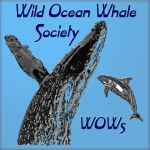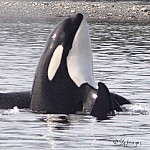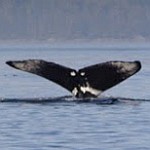Cetacean Terminology in Layman’s Language
Amphipods – Tiny shrimp-like crustaceans that are frequently found in sand and mud of the shorelines.
Baleen – Filters instead of teeth; used by some whales to strain their mouthfuls of food from the water. Baleen is comb like in appearance and made up of material similar to human fingernails.
Blow – Exhaling prior to taking another breath; this can also be called a Spout since the blow is a combination of air and water which is what makes each unique and visible.
Blowhole – Equivalent to human nostrils through which cetaceans breathe.
Breach – Jumping out of the water, majority of whale leaping out of the water.
Bubble net – Method of blowing a circle of bubbles to ‘net’ and confuse small fish, krill and other food into a tight ball prior to lunging up through the middle to maximize available food. Technique used by Humpback whales
Cetacean – Whale, dolphin or porpoise; from the Latin word Cetus; marine mammal that lives entirely in the ocean.
Clan – Group of Orca with similar vocal dialects; A-clan calls are similar to one another as are G-clan calls, yet they are distinctive from one another.
Copepods – Tiny planktonic crustaceans, usually free swimming in the ocean.
Dorsal – Fin extending up from back; a dorsal can be along any part of the back and can be straight or curved.
Echolocation – Clicks produced to echo back an image; similar to sonar, a method of whale underwater visualization.
Euphausiids – Krill; small shrimp-like animals that are free swimming. They feed on plankton, and larger animals feed on them.
Flukes – Horizontal parts of the tail; a whale flukes when he shows his tail usually just before diving or sounding.
Krill – Euphausiids; Tiny shrimp-like critters that are eaten by whales, fish and birds.
Lags – Short for Lagenorhynchus obliquidens or Pacific White Sided Dolphins.
Lobtailing – Lifting the tail and flukes out of the water and slapping it onto the surface of water. May be a social behaviour and/or a form of communication.
Lunge feeding – Method of feeding by rapidly approaching prey with mouth wide open allowing the whale to maximize the intake of prey. Lunge feeding is observed in Rorquals.
Matriline – Killer (Orca) whales that are linked by maternal descent.
Mysticeti – Whales that use baleen; have a pair of blowholes.
Odontocetes – Toothed whale; whales with one blowhole and have teeth, includes Sperm whale, Killer whale (Orca) and all dolphins and porpoises.
Offshore Orca – Killer Whales that tend to stay in the open ocean areas rather than the inside waterways, believed to feed primarily on sharks and large ocean fish such as halibut
Pectoral – Flippers on either side of the animal; used for steerage, balance and as with Humpbacks and Orca, slapping the water.
Plankton – Tiny, even microscopic plants and animals that drift in the oceans. They are basically the bottom of the food chain and fed on by larger animals.
Pleats – Ventral Pleats – Folds along throat and under the mouth of baleen whales that expand as they gulp in food and water prior to filtering or straining.
Pod – Social group of whales that tend to stay and travel together. Due to the amount of research, it is more in depth when it comes to Orca as the pods are more defined along matriarchal lineage.
Porpoising – A behaviour observed when dolphins make regular low-jumps out of the water while travelling quickly near the surface of the water.
Saddle or Saddlepatch – Area immediately behind the dorsal fin of a whale; with Killer (Orca) whales, it is similar in shape to a saddle, is usually lighter in colour, and offers identifiable markings that are unique to the individual whale.
Spyhop – Lifting head out of the water to see surroundings. Quite often a whale must position themselves vertically to do this, giving the appearance of a ‘hop’.
Resident (Orca) – Fish eating Killer Whale; Orca that primarily eat salmon, halibut and other fish. They tend to travel within the same range for the majority of the year.
Rorqual – Category of whale that takes large gulps of food and water prior to filtering through the baleen. Lunge feeding Blue, Humpback and Minke whales are just some that are Rorquals.
Sound – Diving; usually in reference to a deeper dive.
Transient (Orca) – Meat eating Killer Whale; Orca that primarily eat seals, dolphins, porpoises, other whales, and birds. They do not stay very long in any area and therefore are known as Transients.
Trumpeting – A behaviour in Humpback whales where air is forced through the blowholes to produce a loud sound; often observed when Humpbacks are annoyed such as being surrounded by many dolphins.
Vocalization – Squeeks, chirps, whistles, groans and chattering sounds made by cetaceans through various methods of moving air to make sounds including the specific “clan” dialects of Orca and the “singing” of Humpback whales.
Feel free to email me if you feel some other word should be added to this list.


